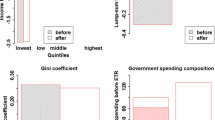Abstract
Preexisting distortions in factor markets complicate the estimation of the social welfare effects of regulatory interventions. The existence of these tax interaction effects (TIEs) suggests that general equilibrium (GE) approaches should be used to evaluate regulatory policies. However, formal GE analysis is not always feasible for the numerous environmental regulations proposed by federal, state, and local agencies. The question addressed in this paper is whether an empirically based ‘‘rule of thumb’’ upward adjustment factor is appropriate to properly scale social cost estimates in environmental policy. We argue that such rule of thumb adjustments are significantly less reliable than estimates based on a detailed general equilibrium analysis because of the uncertainty about both the magnitude and sign of the social cost distortion. In addition to addressing this question, the paper gives an overview of TIEs and their relevance to environmental policy.
Similar content being viewed by others
Abbreviations
- CGE:
-
computable general equilibrium
- GE:
-
general equilibrium
- PE:
-
partial equilibrium
- TIEs:
-
tax interaction effects
References
C. Ballard J. Shoven J. Whalley (1985) ArticleTitle‘General Equilibrium Computations of the Marginal Welfare Costs of Taxation in the United States’ American Economic Review 75 IssueID1 128–138
T. Bayindir-Upmann M. G. Raith (2003) ArticleTitle‘Should High-Tax Countries Pursue Revenue-Neutral Ecological Tax Reforms?’ European Economic Review 47 IssueID1 41–60
A. L. Bovenberg R. A. de Mooij (1994a) ArticleTitle‘Environmental Levies and Distortionary Taxation’ American Economic Review 84 IssueID4 1085–1089
A. L. Bovenberg R. A. de Mooij (1994b) ArticleTitle‘Environmental Taxes and Labor Market Distortions’ European Review of Political Economy 10 655–683
A. L Bovenberg L. H. Goulder (1996) ArticleTitle‘Optimal Environmental Taxation in the Presence of Other Taxes: General Equilibrium Analyses’ American Economic Review 86 IssueID4 985–1000
A. L. Bovenberg F. van der Ploeg (1996) ArticleTitle‘Optimal Taxation, Public Goods, and Environmental Policy with Unvoluntary Unemployment’ Journal of Public Economics 62 59–83
E. Browning (1987) ArticleTitle‘On the Marginal Welfare Cost of Taxation’ American Economic Review 77 11–23
A. Deaton J. Muellbauer (1980) Economics and Consumer Behavior Oxford University Press Cambridge
V. R. Fuchs A. B. Krueger J. M. Poterba (1998) ArticleTitle‘Economists’ Views about Parameters, Values, and Policies:Survey Results in Labor and Public Economics’ Journal of Economic Literature 36 1387–1425
D. Fullerton G. Metcalf (2001) ArticleTitle‘Environmental Controls, Scarcity Rents, and Pre-Existing Distortions’ Journal of Public Economics 80 249–267
E. Goodstein (2002) ArticleTitle‘Labor Supply and the Double-dividend’ Ecological Economics 42 101–106
L. H. Goulder I. W. H. Parry (2000) ArticleTitle‘Green Tax Reform and the Double Dividend’ AERE Newsletter 20 IssueID1 9–13
L. H. Goulder I. W. H. Parry D. Burtraw (1997) ArticleTitle‘Revenue-Raising versus Other Approaches to Environmental Protection: The Critical Significance of Preexisting Tax Distortions’ RAND Journal of Economics 28 708–731
L. H. Goulder I. W. H. Parry R. C. Williams SuffixIII D. Burtraw (1999) ArticleTitle‘The Cost-Effectiveness of Alternative Instruments for Environmental Protection in a Second-Best Setting’ Journal of Public Economics 72 329–360
A. C. Harberger (1964) ArticleTitle‘Principles of Efficiency: The Measurement of Waste’ American Economic Review 54 IssueID3 58–76
M. Hazilla R. Kopp (1990) ArticleTitle‘Social Cost of Environmental Regulations: A General Equilibrium Analysis’ Journal of Political Economy 98 IssueID4 853–872
D. W. Jorgenson P. J. Wilcoxen (1990) ArticleTitle‘Environmental Regulation and U.S. Economic Growth’ RAND Journal of Economics 21 IssueID2 314–340
J. Kahn A. Farmer (1999) ArticleTitle‘The Double Dividend, Second-Best Worlds, and Real-World Environmental Policy’ Ecological Economics 30 433–439
M. F. Kokoski V. K. Smith (1987) ArticleTitle‘A General Equilibrium Analysis of Partial-Equilibrium Welfare Measures: The Case of Climate Change’ American Economic Reviews 77 IssueID3 331–341
J. E. Lithgart F. van der Ploeg (1999) ArticleTitle‘Environmental Policy, Tax Incidence and the Cost of Public Funds’ Environmental and Resource Economics 13 187–207
Murray, B. C., W. N. Thurman and A. Keeler (2002), ‘Tax Interaction Effects, Environmental Regulation, and ‘Rule of Thumb’ Adjustments to Social Cost’, Unpublished working paper.
D. V. Nestor C. A. Pasurka SuffixJr. (1995) ArticleTitle‘CGE Model of Pollution Abatement Processes for Assessing the Economic Effects of Environmental Policy’ Economic Modelling 12 IssueID1 53–59
I. W. H. Parry (1997) ArticleTitle‘Environmental Taxes and Quotas in the Presence of Distorting Taxes in Factor Markets’ Resource and Energy Economics 19 203–220
I. W. H. Parry (1999) ArticleTitle‘Agricultural Policies in the Presence of Distorting Taxes’ American Journal of Agricultural Economics 81 212–230
I. W. H. Parry A. M. Bento (2000) ArticleTitle‘Tax Deductions, Environmental Policy, and the ‘Double-Dividend’ Hypothesis’ Journal of Environmental Economics and Management 39 67–96
K. Schneider (1997) ArticleTitle‘Involuntary Unemployment and Environmental Policy: The Double Dividend Hypothesis’ Scandinavian Journal of Economics 99 45–49
J. Schwartz R. Repetto (2000) ArticleTitle‘Nonseparable Utility and the Double Dividend Debate: Reconsidering the Tax-Interaction Effect’ Environmental and Resource Economics 15 149–157
U. S. Environmental Protection Agency (1999), ‘Summary Minutes of Public Teleconference, Science Advisory Board, Advisory Council on Clean Air Compliance’, October 1, 1999.
West, S. and R. C. Williams III (2002), ‘Empirical Estimates for Environmental Policy Making in a Second-Best Setting’, Unpublished working paper.
R.C. Williams SuffixIII (1999) ArticleTitle‘Revisiting the Cost of Protectionism: The Role of Tax Distortions in the Labor Market’ Journal of International Economics 47 429–447
R. Williams SuffixIII (2000) ArticleTitle‘Environmental Tax Interactions when Pollution Affects Health or Productivity’ Journal of Environmental Economics and Management 44 261–270
Author information
Authors and Affiliations
Corresponding author
Rights and permissions
About this article
Cite this article
Murray, B.C., Keeler, A. & Thurman, W.N. Tax Interaction Effects, Environmental Regulation, and “Rule of Thumb” Adjustments to Social Cost. Environ Resource Econ 30, 73–92 (2005). https://doi.org/10.1007/s10640-004-2379-1
Issue Date:
DOI: https://doi.org/10.1007/s10640-004-2379-1




